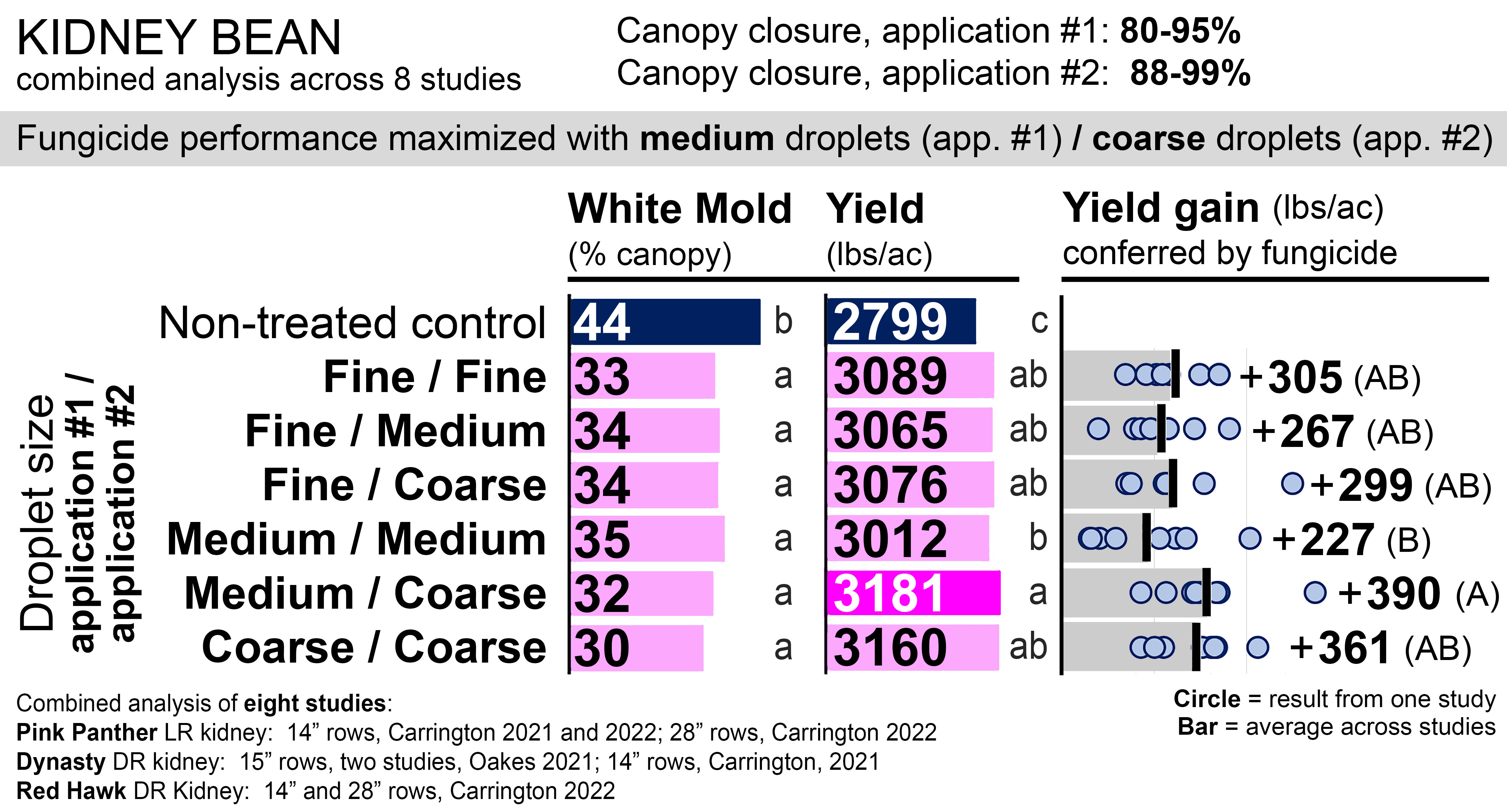Optimizing fungicide spray droplet size for improved management of white mold in pinto and kidney beans
The standard recommendation for fungicide applications targeting white mold in dry beans is to apply fungicides in a minimum 15 gal/ac and with nozzles and pressure emitting a fine droplet spectrum. However, data are lacking to support this recommendation. Fine droplets do not have the velocity to penetrate the interior of the canopy where white mold develops, and recent research conducted on soybeans indicates that sharp gains in fungicide performance can be achieved by calibrating droplet size to canopy closure. The impact of fungicide spray volume of white mold management has not been rigorously quantified.
METHODS:
Field trials were conducted in Carrington and Oakes, ND in 2021 to 2022 quantifying the impact of fungicide droplet size on white mold management in dry beans. Fungicides were applied at early bloom and initial pod (Topsin, 40 fl oz/ac) and 10-14 days later (Endura, 8 oz/ac) to ‘Palomino’ pinto beans, ‘Pink Panther’ light-red kidney beans, ‘Dynasty’ dark-red kidney beans, and ‘Red Hawk’ dark-red kidney beans. Dry beans were seeded to rows 14, 15, or 28 inches apart at a seeding rate of 90,000 viable seeds/ac. Testing was conducted with a tractor-mounted sprayer equipped with a pulse-width modulation system (Capstan AG; Topeka, KS) with pulse width modified as needed to maintain a constant spray volume (15 gal/ac) and driving speed across treatments. Driving speed was 6.0 mph (Oakes, 2021), 10.0 mph (Carrington and Oakes, 2022), or 10.5 mph (Carrington, 2021). Fine droplets were applied with TeeJet XR11005 nozzles at 60 psi or XR11004 nozzles at 60 psi, medium droplets were applied with XR11006 nozzles at 35 psi, and coarse droplets were applied with XR11010 nozzles at 30 psi.
The studies in Carrington (2021 and 2022) and Oakes (2022) were conducted under conventional tillage. In Oakes in 2021, testing was conducted with and without a rye cover crop, with dry beans (1) direct-seeded into fallow ground, (2) seeded into winter rye that terminated 14 days before planting, and (3) seeded winter rye that terminated within 24 hours of planting. The rye treatments were utilized to facilitate testing in dry beans that differed in canopy closure at early bloom.
Studies were conducted with six to twelve replicates. Within each experimental replicate, each fungicide treatment was applied to a block of all of the dry bean market classes and varieties planted back-to-back, resulting in all varieties being sprayed concurrently with the exact same fungicide mix and sprayer calibration. The sprayer was turned on or off in a non-harvested filler plot established before, between, and after treatment blocks.
FINDINGS:
White mold management and dry bean yield were optimized by increasing spray droplet size between application 1 and 2 as the canopy became denser.
- Pinto beans: In four of eight studies, white mold management was optimized with fine droplets in the first application and medium droplets at the second application. In four of eight studies, white mold management was optimized with medium droplets in the first application and coarse droplets in the second application (Figure 1). Visual estimates of canopy closure were similar in each set of studies, and additional research is needed to identify the canopy characteristics when fine droplets vs. medium droplets are optimal in the first application.
- Kidney beans: When the canopy was moderately open to nearing closure (80-95% of the ground covered) at the first fungicide application and at or near closure (88-99% of the ground covered) at the second fungicide application, kidney bean yield under white mold pressure was optimized by applying fungicides with medium droplets in the first application and coarse droplets in the second application (Figure 2).
Optimizing fungicide droplet size improved dry bean yields under white mold pressure by 32% versus the standard recommendation of always applying fungicides with fine droplets and by 64% versus the least-effective droplet size combinations tested.
The canopy characteristics at which fungicides targeting white mold should be applied with fine versus medium droplets in pinto beans at early bloom remains unclear. Canopy density, canopy closure, and the consistency of canopy closure across the field are likely determinants of optimal droplet size, with fine droplets most likely to optimal in more open, less dense canopies.
Follow-up research is planned for the 2023 field season to confirm the results obtained in the kidney bean studies and to identify the canopy characteristics at which fine versus medium droplets optimize fungicide performance against white mold in pinto beans at early bloom.


Research was conducted by Michael Wunsch, Jesse Hafner, Suanne Kallis, and Aaron Fauss; NDSU Carrington Research Extension Center. Kelly Cooper, Heidi Eslinger, and Spencer Eslinger; NDSU Robert Titus Irrigation Research Site, Oakes.
Michael Wunsch, Ph.D.
Michael.Wunsch@ndsu.edu
Plant Pathologist
